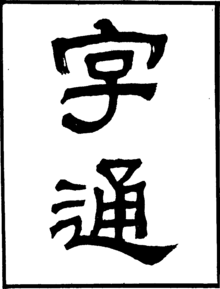Zitong (dictionary)
| Zitong | |||||||||||||||||||||
|---|---|---|---|---|---|---|---|---|---|---|---|---|---|---|---|---|---|---|---|---|---|
 Zitong title page in clerical script | |||||||||||||||||||||
| Chinese name | |||||||||||||||||||||
| Chinese | |||||||||||||||||||||
| Literal meaning | character mastery | ||||||||||||||||||||
| |||||||||||||||||||||
| Korean name | |||||||||||||||||||||
| Hangul | |||||||||||||||||||||
| Hanja | 자통 | ||||||||||||||||||||
| |||||||||||||||||||||
| Japanese name | |||||||||||||||||||||
| Kanji | |||||||||||||||||||||
| |||||||||||||||||||||
The Zitong is a 1254 Chinese dictionary of that was compiled by the Southern Song dynasty (1127–1279) scholar Li Congzhou
Title[edit]
The title combines two common words: zì
Li Congzhou's choice of title was the name of an earlier character dictionary that is now a lost work: the (c. 500) Zitong
The similarly titled (1671) Zhengzitong
Furthermore, the Japanese lexicographer Shirakawa Shizuka
History[edit]
In an alphabetic language like English, orthography means "Correct or proper spelling; spelling according to accepted usage; the way in which words are conventionally written. (By extension) Any mode or system of spelling." (OED 2009, v. 4.0). When semantically extended into a logographic language like Chinese, it means "the way in which Chinese characters are conventionally written", which includes calligraphic aspects such as the script styles, stroke order, and character structure.
The first Chinese orthographic dictionaries, or "'character model' dictionaries", were compiled during the Tang dynasty (618–907) in an effort to rectify discrepancies among characters written in seal, clerical, and regular scripts, and to standardize variant characters.[6] Emperor Taizong of Tang put the scholar and calligrapher Yan Shigu (581–645) in charge of the Palace Library in order to "verify and authorize" the Five Classics.[7] The Archival Bureau's duties were to print authoritative editions of the classic works, to collate the styles of characters, to check and proofread government texts, and to produce a standard orthographic handbook. This became the first Chinese orthographic dictionary, Yan Shigu's book the Zìyàng
In addition to the Zitong, various orthography dictionaries and character books were published during the Song dynasty (960–1279), for instance, the Fugubian 复古
Text[edit]
The Zitong was in one volume, and based upon the classic (121) Shuowen jiezi character dictionary. It included 601 character head entries, which were arranged into 89 sections according to the number of strokes in the regular script. The head character was in seal script and entries were in regular script, giving notation first, followed by the definition. All the exegetic interpretations quote the Shuowen jiezi without any other sources.
There were flaws in the Zitong, such as listing some characters twice and inconsistencies in the 89-radical system. It did have a useful appendix with 82 popular erroneous writings, such as yīchang
References[edit]
- Yong, Heming; Peng, Jing (2008). Chinese Lexicography: A History from 1046 BC to AD 1911. Oxford University Press.
Footnotes
- ^ a b Zhou Youguang
周 有光 (2003), The Historical Evolution of Chinese Languages and Scripts, tr. by Zhang Liqing張 立 青 National East Asian Languages Resource Center, Ohio State University. p. 72. - ^ a b Yong & Peng 2008, p. 198.
- ^ a b Theobald, Ulrich (2013), Zitong
字 通 "(A Scholar) Versed in Characters", Chinaknowledge. - ^ Lin Yuan (2008), "Zitong Gouchen"《
字 统》勾沉" [Recovering the Zitong], Gu Hanyu yanjiu古 汉语研究 3.80: 85-88. (in Chinese) - ^ Xu Shiyi
徐 时仪 (2013)北朝 字 书《字 统》佚文 钩沉 [Recovering the Lost Zitong], Zhongguo wenxue yanjiu中国 文字 研究 17. (in Chinese) - ^ Yong & Peng 2008, pp. 197, 177.
- ^ Tr. Yong & Peng 2008, p. 194.
